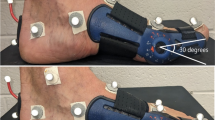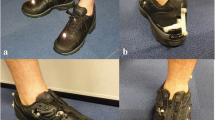Abstract
Introduction
The aim of the current investigation was to examine the effects of both lateral orthoses and toe-in/ toe-out foot progression angles on lower extremity joint loading during walking using a musculoskeletal simulation approach.
Methods
The current investigation examined 15 healthy males, walking in 6 different conditions (neutral, lateral orthoses, toe-in, lateral toe-in, toe-out and lateral toe-out). Walking kinematics were collected using an eight-camera motion capture system, and kinetics via an embedded piezoelectric force plate. Lower extremity joint loading was explored using a musculoskeletal simulation approach.
Results
This investigation showed that peak patellofemoral joint stress was greater in the neutral (3.96 kPa/BW) and lateral orthoses (4.20 kPa/BW) conditions compared to toe-in (3.33 kPa/BW), lateral toe-in (3.43 kPa/BW), toe-out (3.35 kPa/BW) and lateral toe-out (3.53 kPa/BW) and ankle joint impulse larger in the toe-in (1.65BW·s) and toe-out (1.62BW·s) foot progression angle modalities compared to neutral (1.51BW·s) and lateral orthoses (1.53BW·s). Furthermore, it was also shown that medial tibiofemoral impulse was statistically greater in the toe-in (1.20BW·s) and lateral toe-in (1.15BW·s) conditions compared to neutral (1.07BW·s), lateral orthoses (1.07BW·s), toe-out (1.09BW·s) and lateral toe-out (1.05BW·s).
Conclusions
Therefore, the current investigation provides evidence that altering the foot progression angle may attenuate the risk from patellofemoral disorders whilst simultaneously enhancing the risk from degenerative ankle pathologies. Similarly, adopting a toe-in foot progression angle may also increase the risk from medial tibiofemoral degeneration.




Similar content being viewed by others
References
Khan SS, Khan SJ, Usman J (2017) Effects of toe-out and toe-in gait with varying walking speeds on knee joint mechanics and lower limb energetics. Gait Posture 53:185–192
Farrokhi S, Keyak JH, Powers CM (2011) Individuals with patellofemoral pain exhibit greater patellofemoral joint stress: a finite element analysis study. Osteoarthritis Cartilage 19:287–294
Kutzner I, Trepczynski A, Heller MO, Bergmann G (2013) Knee adduction moment and medial contact force–facts about their correlation during gait. PLoS ONE 8(12):e81036
Griffin TM, Guilak F (2005) The role of mechanical loading in the onset and progression of osteoarthritis. Exerc Sport Sci Rev 33(4):195–200
Felson DT (2004) Risk factors for osteoarthritis: understanding joint vulnerability. Clin Orthop Relat Res 427:16-S21
Hunter DJ, McDougall JJ, Keefe FJ (2008) The symptoms of osteoarthritis and the genesis of pain. Rheum Dis Clin N Am 34(3):623–643
Jones RK, Chapman GJ, Forsythe L, Parkes MJ, Felson DT (2014) The relationship between reductions in knee loading and immediate pain response whilst wearing lateral wedged insoles in knee osteoarthritis. J Orthop Res 32(9):1147–1154
Peat G, McCarney R, Croft P (2001) Knee pain and osteoarthritis in older adults: a review of community burden and current use of primary health care. Ann Rheum Dis 60(2):91–97
Jackson BD, Wluka AE, Teichtahl AJ, Morris ME, Cicuttini FM (2004) Reviewing knee osteoarthritis—a biomechanical perspective. J Sci Med Sport 7(3):347–357
Miyazaki T, Wada M, Kawahara H, Sato M, Baba H, Shimada S (2002) Dynamic load at baseline can predict radiographic disease progression in medial compartment knee osteoarthritis. Ann Rheum Dis 61(7):617–622
Morgenroth DC, Medverd JR, Seyedali M, Czerniecki JM (2014) The relationship between knee joint loading rate during walking and degenerative changes on magnetic resonance imaging. Clin Biomech 29(6):664–670
Xing F, Lu B, Kuang MJ, Wang Y, Zhao YL, Zhao J, Ma XL (2017) A systematic review and meta-analysis into the effect of lateral wedge arch support insoles for reducing knee joint load in patients with medial knee osteoarthritis. Medicine 96(24):e7168
Sinclair J (2018) Mechanical effects of medial and lateral wedged orthoses during running. Phys Ther Sport 32:48–53
Jones RK, Chapman GJ, Findlow AH, Forsythe L, Parkes MJ, Sultan J, Felson DT (2013) A new approach to prevention of knee osteoarthritis: reducing medial load in the contralateral knee. J Rheumatol 40(3):309–315
Hinman RS, Payne C, Metcalf BR, Wrigley TV, Bennell KL (2008) Lateral wedges in knee osteoarthritis: what are their immediate clinical and biomechanical effects and can these predict a three-month clinical outcome? Arthritis Care Res 59(3):408–415
Alshawabka AZ, Liu A, Tyson SF, Jones RK (2014) The use of a lateral wedge insole to reduce knee loading when ascending and descending stairs in medial knee osteoarthritis patients. Clin Biomech 29(6):650–656
Hunt MA, Takacs J (2014) Effects of a 10-week toe-out gait modification intervention in people with medial knee osteoarthritis: a pilot, feasibility study. Osteoarthritis Cartilage 22(7):904–911
Van den Noort JC, Schaffers I, Snijders J, Harlaar J (2013) The effectiveness of voluntary modifications of gait pattern to reduce the knee adduction moment. Hum Mov Sci 32(3):412–424
Lynn SK, Kajaks T, Costigan PA (2008) The effect of internal and external foot rotation on the adduction moment and lateral–medial shear force at the knee during gait. J Sci Med Sport 11(5):444–451
Rutherford DJ, Hubley-Kozey CL, Deluzio KJ, Stanish WD, Dunbar M (2008) Foot progression angle and the knee adduction moment: a cross-sectional investigation in knee osteoarthritis. Osteoarthritis Cartilage 16(8):883–889
Jenkyn TR, Hunt MA, Jones IC, Giffin JR, Birmingham TB (2008) Toe-out gait in patients with knee osteoarthritis partially transforms external knee adduction moment into flexion moment during early stance phase of gait: a tri-planar kinetic mechanism. J biomech 41(2):276–283
Herzog W, Clark A, Wu J (2003) Resultant and local loading in models of joint disease. Arthritis Care Res 49:239–247
Delp SL, Anderson FC, Arnold AS, Loan P, Habib A, John CT, Thelen DG (2007) OpenSim: open-source software to create and analyze dynamic simulations of movement. IEEE Trans Biomed Eng 54(11):1940–1950
Cui W, Wang C, Chen W, Guo Y, Jia Y, Du W, Wang C (2019) Effects of toe-out and toe-in gaits on lower-extremity kinematics, dynamics, and electromyography. Appl Sci 9(23):5245
Chang A, Hurwitz D, Dunlop D, Song J, Cahue S, Hayes K, Sharma L (2007) The relationship between toe-out angle during gait and progression of medial tibiofemoral osteoarthritis. Ann Rheum Dis 66(10):1271–1275
Sinclair JK, Edmundson CJ, Brooks D, Hobbs SJ (2011) Evaluation of kinematic methods of identifying gait events during running. Int J Sports Sci Eng 5(3):188–192
Sinclair J, Brooks D, Butters B (2019) Effects of different heel heights on lower extremity joint loading in experienced and in-experienced users: a musculoskeletal simulation analysis. Sport Sci Health 15(1):237–248
Lerner ZF, DeMers MS, Delp SL, Browning RC (2015) How tibiofemoral alignment and contact locations affect predictions of medial and lateral tibiofemoral contact forces. J Biomech 48(4):644–650
Steele KM, DeMers MS, Schwartz MH, Delp SL (2012) Compressive tibiofemoral force during crouch gait. Gait Posture 35(4):556–560
Besier TF, Draper CE, Gold GE, Beaupré GS, Delp SL (2005) Patellofemoral joint contact area increases with knee flexion and weight-bearing. J Orthop Res 23(2):345–350
Pataky TC, Robinson MA, Vanrenterghem J (2013) Vector field statistical analysis of kinematic and force trajectories. J Biomech 46(14):2394–2401
Wagenmakers EJ, Love J, Marsman M, Jamil T, Ly A, Verhagen J, Meerhoff F (2018) Bayesian inference for psychology. Part II: example applications with JASP. Psychonomic Bull Rev 25(1):58–76
Jeffreys H (1961) Theory of probability, 3rd edn. Oxford University Press, Oxford, UK
Liao TC, Samaan MA, Popovic T, Neumann J, Zhang AL, Link TM, Souza RB (2019) Abnormal joint loading during gait in persons with hip osteoarthritis is associated with symptoms and cartilage lesions. J Orthop Sports Phys Ther 49(12):917–924
Delco ML, Kennedy JG, Bonassar LJ, Fortier LA (2017) Post-traumatic osteoarthritis of the ankle: a distinct clinical entity requiring new research approaches. J Orthop Res 35(3):440–453
Sinclair J, Brooks D, Stainton P (2019) Sex differences in ACL loading and strain during typical athletic movements: a musculoskeletal simulation analysis. Eur J Appl Physiol 119(3):713–721
Author information
Authors and Affiliations
Corresponding author
Ethics declarations
Conflict of interest
The authors state that they have no conflict of interest to declare.
Ethical approval
The procedure utilized for this investigation was approved by a university ethical committee (STEMH 1013).
Informed consent
Written informed consent was provided by all participants.
Additional information
Publisher's Note
Springer Nature remains neutral with regard to jurisdictional claims in published maps and institutional affiliations.
Supplementary Information
Below is the link to the electronic supplementary material.
11332_2021_762_MOESM1_ESM.jpg
Comparison of the a hip joint force, b medial tibiofemoral force, c patellofemoral force, d lateral tibiofemoral force, e ankle force and f patellofemoral stress across the stance phase in all conditions. SPM (F) denotes the F value, and critical thresholds for statistical significance are denoted via the horizontal dotted line (JPG 304 KB)
Rights and permissions
About this article
Cite this article
Sinclair, J., Brooks, D., Taylor, P.J. et al. Effects of toe-in/ out toe-in gait and lateral wedge orthoses on lower extremity joint kinetics; an exploration using musculoskeletal simulation and Bayesian contrasts. Sport Sci Health 17, 781–795 (2021). https://doi.org/10.1007/s11332-021-00762-7
Received:
Accepted:
Published:
Issue Date:
DOI: https://doi.org/10.1007/s11332-021-00762-7




